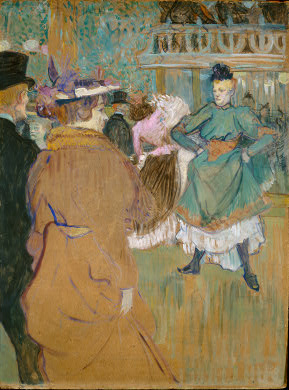February 9: Religion and Nudity
First Public Strip-tease (1893),
Religion v. Nudity
 It was on this date, February 9, 1893, that the first public strip-tease took place in Paris. Perhaps Mona, an artist's model who thought she had more than just the prettiest legs, and, to prove it, jumped nude onto a table for the art students, was unaware that she was making history. She got a 100-franc fine from the police and a riot in protest from her student fans. The Moulin Rouge, which had opened just a few years before, picked up on the idea... and strip-tease was born.
It was on this date, February 9, 1893, that the first public strip-tease took place in Paris. Perhaps Mona, an artist's model who thought she had more than just the prettiest legs, and, to prove it, jumped nude onto a table for the art students, was unaware that she was making history. She got a 100-franc fine from the police and a riot in protest from her student fans. The Moulin Rouge, which had opened just a few years before, picked up on the idea... and strip-tease was born.
The public unveiling of the female body, for the entertainment of an audience and the employment of the performer, has always had the power to set religious mouths gaping. Or gasping. Why does the female body have the power to excite both lust and condemnation? And why is nudity and sexual lust — two different ideas — often conflated in the minds of the putatively pure-minded? Ancient Earth-Mother religious cults glorified the feminine reproductive capacities and would smile at our modern, Christian reticence about nudity. With the triumph of sky-god religions — Judaism, Christianity and Islam — the ascetic idea developed that things of the earth were unclean. And that was especially true of the sexual power of women over men.
Adam and Eve were the first nudists, yet Eve's sin of disobedience to the (male) sky-god caused them both to be ashamed at their nakedness. The story puts the all-powerful Jehovah in the ludicrous role of the first tailor (Genesis 3:21), making garments for the creatures who were until then, perfect in the eyes of God! (see Genesis 1:27, 31) God even punished Ham (Genesis 9:20-27) for looking on his naked father, Noah. In the New Testament, as well, nudity is cause for shame (see Revelation 3:17 and 16:15).
As Christian theology developed, the Gnostic tradition was adopted, with its disdain for the human body and bodily pleasures. St. Paul took a particularly dim view of sexuality, valuing celibacy even over marriage — for those who could stand it. Paul believed that the end of the world was at hand, so it is fortunate for the species that his ideas never caught on. Still, the idea that women are too deafened by the din of their bodies to hear God's word* was fully espoused by the Church Fathers. The flesh was the enemy of the spirit. Genesis 1:31 was gainsaid by Matthew 5:28: "anyone who looks at a woman lustfully has already committed adultery with her in his heart."
So looking on nakedness, especially female nakedness, was a moral evil. In our own day, Pope John Paul II said that nudity itself isn't sinful; rather, the body is obscene only when it is seen as "an object of 'enjoyment,' meant for the gratification of concupiscence itself." In other words, concupiscence (lust) is bad, not nudity. Yet there is no sexual passion, and therefore no procreation, without lust!
And so it is with other areas of human sexuality, wherein church control is essential or there would be no church power: sex-education in the public schools, condom availability, premarital sex, birth control, abortion access, erotic and pornographic material, portrayal of sexual behavior and sexual orientation in the media (including movies), homosexuality, bisexuality, breast-feeding in public, same-sex marriage or civil union, traditional roles in marriage, married clergy, female ordination — even topless sunbathing and nude beaches. As usual, the churches want to license a basic human drive and dispense it only under their control.
But in strip-tease, the amount of control over their bodies and their sexuality is in the hands of the women, where it belongs. The question of exploitation doesn't come out in the way it is popularly assumed. Even lap-dancers, the modern upshot for the private audience of the nude excitation of a public audience, can earn $1500 to $3700 per week. Who is being exploited: the well-paid dancer or the gullible client?
* Paraphrased from the 1994 film Sirens, written and directed by John Duigan.
Originally published February 2004 by Ronald Bruce Meyer.

